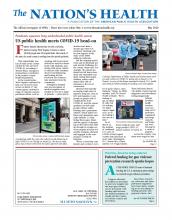A significant number of injury survivors experience post-traumatic stress disorder, and better screening practices could help connect them to mental health services.
In a study published in February in Psychological Medicine, researchers pooled and examined data from than 3,000 people whose injuries were treated in emergency rooms across six countries: Australia, Israel, Japan, the Netherlands, Switzerland and the U.S.
More than 64% of patients could be described as “resilient,” or exhibiting consistently low levels of of PTSD symptoms. However, the remaining patients experienced more serious PTSD symptoms. About 17% initially had high levels of PTSD symptoms that decreased over time and 6.7% had moderate symptoms. Another 5.5% had delayed symptoms and 6.5% experienced chronically high PTSD symptoms.
Study co-author Sarah Lowe, PhD, an assistant professor in the Department of Social and Behavioral Sciences at Yale School of Public Health, said the study goal was to find common predictors that could help providers identify injury patients at higher risk of severe PTSD and connect them with care. According to the Centers for Disease Control and Prevention, U.S. emergency departments reported 40 million injury-related visits in 2017.
“In the past decade or so, there’s been a proliferation of PTSD trajectory studies to elucidate its symptoms over time,” Lowe told The Nation’s Health. “We wanted to find consistent predictors for injury survivors...One of the key findings was that the majority of people are resilient. But about one-third will have elevated symptoms, and that’s a lot of people.”
Violence was the strongest indicator of both immediate and long-term PTSD, Lowe reported. The study found that injuries due to physical assault were especially predictive of immediate and longer-term PTSD symptoms in the year following the injury. Patients with a history of interpersonal violence, such as physical abuse and sexual assault, also faced greater PTSD risk.
Higher educational attainment was associated with fewer PTSD symptoms, and lower educational attainment associated with higher PTSD risk. Female injury patients were more likely to report initially high levels of PTSD symptoms, as well as delayed symptoms. Overall, about 30% of non-military injury survivors in the study experienced moderate to high levels of PTSD symptoms in the first year after an injury.
Lowe said symptoms of PTSD can include nightmares, flashbacks, avoiding people, difficulty sleeping, hyper-vigilance, and feeling angry, irritable, depressed and ashamed.
“It can cause a significant disruption in people’s lives,” she said. “Disruptions in work, in relationships, even in your physical health.”
Lowe said she hopes the findings can help providers, both in emergency and follow-up settings, identify injury survivors at high risk for PTSD and link them to mental health services and support. She noted that there are rapid PTSD screening tools that providers can integrate into their care.
“Given that such a high percentage of people are going to have elevated PTSD symptoms within the first post-trauma year, there needs to be good screening not just in ERs, but in follow-up appointments,” she said. “Intervening early can prevent a domino effect in people’s lives.”
For more information, read the study online.
- Copyright The Nation’s Health, American Public Health Association









